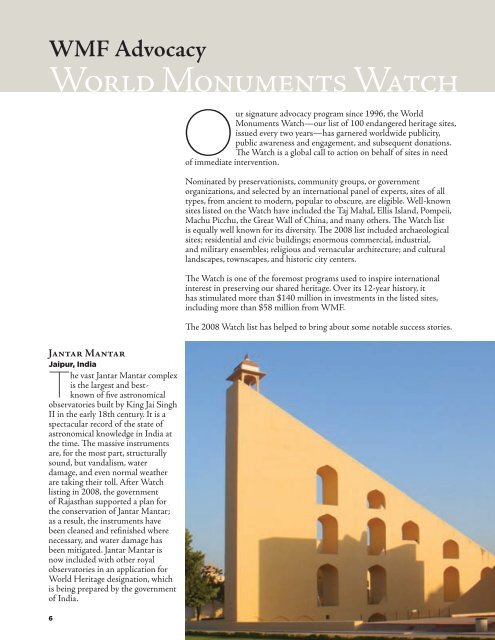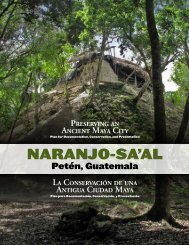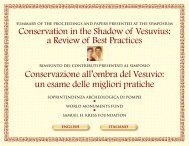2008 Annual Report - World Monuments Fund
2008 Annual Report - World Monuments Fund
2008 Annual Report - World Monuments Fund
You also want an ePaper? Increase the reach of your titles
YUMPU automatically turns print PDFs into web optimized ePapers that Google loves.
WMF Advocacy<br />
<strong>World</strong> <strong>Monuments</strong> Watch<br />
Jantar Mantar<br />
Jaipur, India<br />
The vast Jantar Mantar complex<br />
is the largest and bestknown<br />
of five astronomical<br />
observatories built by King Jai Singh<br />
II in the early 18th century. It is a<br />
spectacular record of the state of<br />
astronomical knowledge in India at<br />
the time. The massive instruments<br />
are, for the most part, structurally<br />
sound, but vandalism, water<br />
damage, and even normal weather<br />
are taking their toll. After Watch<br />
listing in <strong>2008</strong>, the government<br />
of Rajasthan supported a plan for<br />
the conservation of Jantar Mantar;<br />
as a result, the instruments have<br />
been cleaned and refinished where<br />
necessary, and water damage has<br />
been mitigated. Jantar Mantar is<br />
now included with other royal<br />
observatories in an application for<br />
<strong>World</strong> Heritage designation, which<br />
is being prepared by the government<br />
of India.<br />
6<br />
Our signature advocacy program since 1996, the <strong>World</strong><br />
<strong>Monuments</strong> Watch—our list of 100 endangered heritage sites,<br />
issued every two years—has garnered worldwide publicity,<br />
public awareness and engagement, and subsequent donations.<br />
The Watch is a global call to action on behalf of sites in need<br />
of immediate intervention.<br />
Nominated by preservationists, community groups, or government<br />
organizations, and selected by an international panel of experts, sites of all<br />
types, from ancient to modern, popular to obscure, are eligible. Well-known<br />
sites listed on the Watch have included the Taj Mahal, Ellis Island, Pompeii,<br />
Machu Picchu, the Great Wall of China, and many others. The Watch list<br />
is equally well known for its diversity. The <strong>2008</strong> list included archaeological<br />
sites; residential and civic buildings; enormous commercial, industrial,<br />
and military ensembles; religious and vernacular architecture; and cultural<br />
landscapes, townscapes, and historic city centers.<br />
The Watch is one of the foremost programs used to inspire international<br />
interest in preserving our shared heritage. Over its 12-year history, it<br />
has stimulated more than $140 million in investments in the listed sites,<br />
including more than $58 million from WMF.<br />
The <strong>2008</strong> Watch list has helped to bring about some notable success stories.
















